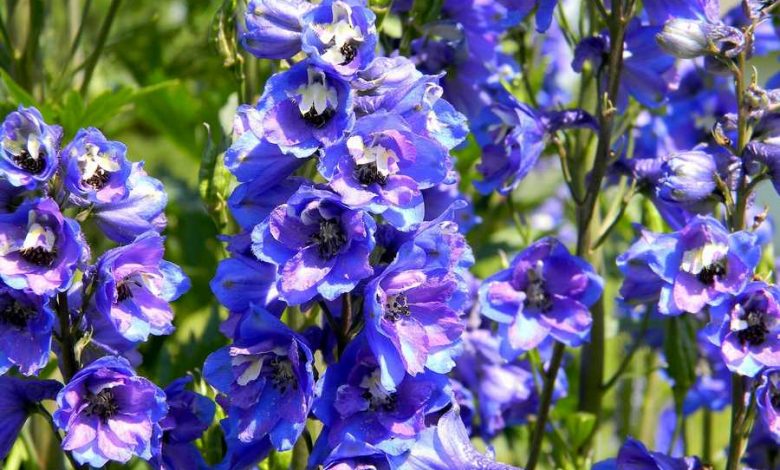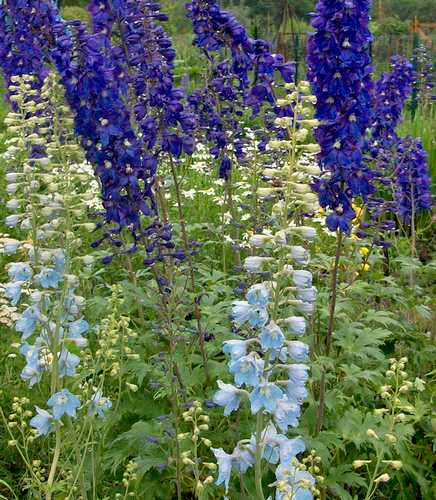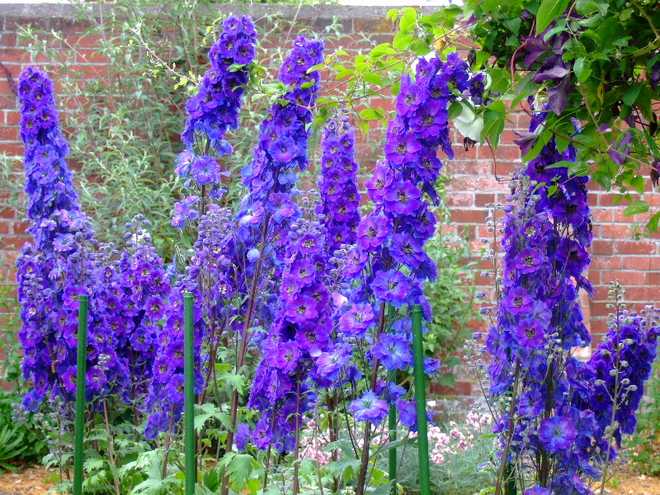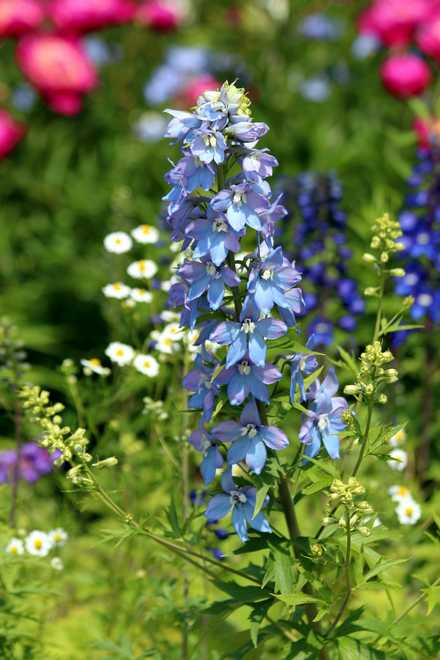
In June, perennial Delphiniums, also called larkspurs, offer large spikes of blue flowers in the garden beds. To obtain a generous flowering, they need some care.
What there is to know :
Botanical name : Delphinium grandiflorum sinensis, Delphinium elatum
Common name : Delphinium, Larkspur, Dauphinelle high
Family: Ranunculaceae
Height: Different depending on the species, between 30 cm and more than 1.50 m in height
Exposure : In the sun, sheltered from strong winds
Soil : Rich and well drained. The earth must remain cool, but not excessively, especially in winter.
Hardiness : -30°C
Planting a blue Delphinium in the ground
Plant your perennial in rich, slightly hearty soil. Its first (June, July) and second (September, October) flowering will be more beautiful if you choose a place in the garden in the sun , sheltered from the wind .
This planting is done at the beginning of spring, in March or April, or better, from September, until November.
Choose a beautiful plant in a pot, if possible in bloom. This way you will be sure of the color of the flowers. Its stem should be thick and strong .
Here are the steps to plant it properly:
- Dig a 40 cm side hole;
- Add 2 or 3 handfuls of potting soil to mix with the garden soil;
- Install a stake and tie the plant to it;
- Plug the hole, water;
- Do not forget to put slug pellets around the feet.
4 blue or white Delphiniums are enough to cover an area of one square meter. Their clumps grow rapidly.

Pot planting
In spring or autumn, choose a large pot of at least 20 cm in diameter.
- Place a bed of gravel or clay pebbles on the bottom to obtain good drainage.
- Use a mixture of garden soil, horticultural soil and horse manure or seaweed.
- Install the Delphinium in the center of the container, slightly burying the collar so that the plant takes root better.
- Don’t forget the stake if your variety is tall.
- In pots, frequent watering and fertilizing are important if you want to get beautiful blooms.
Seed sowing
Not all Delphiniums are propagated by seed, especially hybrids and high dolphinella.
Sowing the seeds of other Delphiniums does not always give the desired flower colors.
This sowing is carried out in April directly in a bucket or in boxes filled with compost. Keep them warm under a frame. You can transplant the plants in the ground from late spring.
A first flowering at the end of August or the beginning of September is then possible.
Perennial Delphinium Care
Watering: Water regularly, spread a mulch to keep the soil cool.
Weeding your beds: Watch for the appearance of weeds; pull them out as soon as possible.
Fight against the main Delphinium diseases: Treat the plants with Bordeaux mixture against powdery mildew as soon as the first white spots appear on the leaves.
In addition, slugs and snails cut off growing flower stalks. Watch your Delphiniums closely!
Staking: Tie the stems of large larkspur to their stake as they rise.
When to prune Delphiniums? To obtain a nice second bloom, cut back the stems and leaves to 20 cm from the ground in July, when the flowers have faded.
Then water generously, add compost to the base of your perennials and lay out slug pellets.
After the second flowering in September or October, let the plant slowly dry out. Instead, wait until February to completely clean the plants and cut them back to 20 cm from the ground.

Multiplication of perennial Delphiniums
Perennial larkspur are greedy. They quickly exhaust the soil. Their stems then grow less tall and their flowering becomes less beautiful.
To keep many flowers, it is therefore necessary to divide the strains of perennial Delphiniums every 4 years, in October or November.
Which plants to associate with larkspur?
In the flower beds, the most beautiful associations are obtained with flowering shrubs, roses, large bellflowers , peonies or shrub sage .
Demanding perennials
The stems of your Delphiniums are not growing and flowering ? The soil is probably too poor or too dry.
The leaves of your plants are turning yellow and their stems are not strong? The soil is probably too compact and too wet.
Some varieties of perennial Delphiniums
There are several species of Delphiniums, each of which has several diversely colored varieties. Nevertheless, blue tones dominate.
The large Delphiniums of the Pacific Giant group
All these varieties of perennial larkspur have a large, sparsely branched stem exceeding 1.50 m in height. Many are double-flowered and bear black or white stamens forming a central patch.
Blue Bird : bright blue with white spot.
Blue Jay : a pretty light blue Delphinium with a black spot
King Arthur : dark purple, white in the center
Black knight : purple with black stamens
Guinevere : Rose with a white spot
Astolat : with nuanced pink tones
Galahad : entirely white
Percival : White with black stamens in contrast
Round Table : in a mix of all the colors
Summer skies : in nuanced blue tones
Magic fountains : in a mix of colours. These Delphiniums are also smaller (75 cm in height)
The Tall Dolphin, Delphinium elatum
This variety has dense and slender flower stalks. It can only be propagated by cuttings or by division of clumps, which explains why it is rarer.
Ouvertüre : a delphinium with shades of blue shaded with pink and a black spot.
Finsteraarhorn : deep blue-purple with black eye
Jubelruf : with semi-double blue flowers
Alice Artindale : double flowers, mauve bordered with blue
Tiddles : with blue-grey flowers
Sungleam : with original creamy yellow flowers
Strawberry Fair: with raspberry-pink flowers

Belladonna Hybrid Delphiniums
Less tall than their cousins (between 80 cm and 1.20 m in height), they are bushier and branched but also more demanding.
Casa blanca and Moerjeimii : pure white
Cliveden beauty : light blue
Atlantis : dark violet
Lamartine : deep blue.
Piccolo : Ultramarine blue
Völkerfreiden : blue-violet
Dwarf Delphiniums
These low varieties (height of 30 cm) rarely resist excess humidity in winter. Instead, plant them in pots or improve soil drainage.
Blue Butterfly, with beautiful blue flowers
Tom thumb , with blue flowers.
Delphinium nudicaule , a red lark’s foot.
